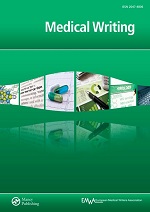
Volume 21, Issue 4 - Obesity and Type 2 Diabetes
Improving patient communication by writing with empathy
Authors: Stefan Lang, Marc Esser
Abstract
Medical writers’ texts are either written for specialists or for non-professionals such as patients and their relatives. Medical writers whose work is intended for patients cannot merely impart facts. They also need to demonstrate that they comprehend the patient's emotions – they must write with empathy. Empathic texts are intelligible, credible, and are written from the patient's perspective. They can help patients realistically appreciate their situation and assess the advantages and disadvantages of different therapy options. In this way, empathic writing can promote health-conscious behaviour and can foster treatment adherence.
 Download the full article
Download the full article
References
- Butow P, Brindle E, McConnell D, Boakes R, Tattersall M. Information booklets about cancer: factors influencing patient satisfaction and utilization. Patient Educ Couns 1998;33(2):129–41.
- Langer I, von Schulz F, Tausch R. Verständlichkeit in Schule, Verwaltung, Politik und Wissenschaft [Intelligibility in Schools, Administration, Politics, and Science]. München, Basel: Ernst Reinhardt; 1974.
- Beck RS, Daughtridge R, Sloane PD. Physician-patient communication in the primary care office: a systematic review. J Am Board Fam Pract 2002;15(1):25–38.
- Rakel D, Barrett B, Zhang Z, Hoeft T, Chewning B, Marchand L, et al. Perception of empathy in the therapeutic encounter: effects on the common cold. Patient Educ Couns 2011;85(3):390–7.
- Levinson W, Gorawara-Bhat R, Lamb J. A study of patient clues and physician responses in primary care and surgical settings. JAMA 2000;284(8):1021–7.
Search
Articles
Links
Editoral Board
Editor-in-Chief
Co-Editors
Managing Editor
Victoria White
Associate Editors
Section Editors
AI/Automation
Biotechnology
Digital Communication
EMWA News
Gained in Translation
Getting Your Foot in the Door
Good Writing Practice
In the Bookstores
Publications
Medical Communications/Writing for Patients
Medical Devices
My First Medical Writing
News from the EMA
Freelancing
Pharmacovigilance
Regulatory Matters
Regulatory Public Disclosure
Teaching Medical Writing
Louisa Ludwig-Begall / Sarah Kabani
The Crofter: Sustainable Communications
Veterinary Writing
Editors Emeritus
Layout Designer
Chris Monk
 Visit the EMWA website
Visit the EMWA website